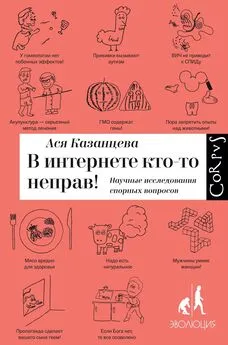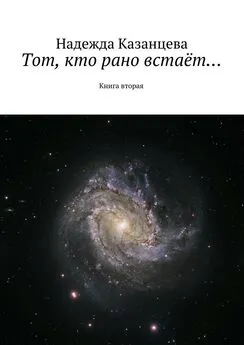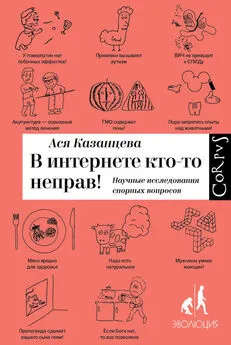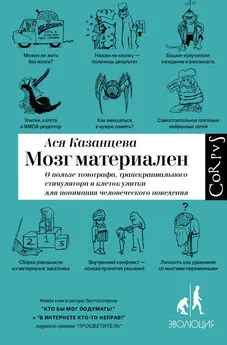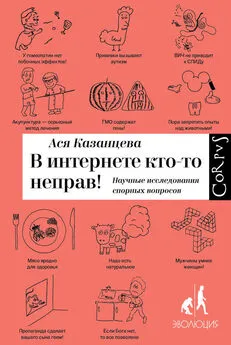Анастасия Казанцева - В интернете кто-то неправ!
- Название:В интернете кто-то неправ!
- Автор:
- Жанр:
- Издательство:АСТ : CORPUS
- Год:2016
- Город:Москва
- ISBN:978-5-17-092181-2
- Рейтинг:
- Избранное:Добавить в избранное
-
Отзывы:
-
Ваша оценка:
Анастасия Казанцева - В интернете кто-то неправ! краткое содержание
Первую книгу Аси Казанцевой «Кто бы мог подумать? Как мозг заставляет нас делать глупости» высоко оценили ученые и обычные читатели — уже несколько лет она остается бестселлером. В 2014 году книга была удостоена премии «Просветитель». Во всем, что делает Ася, будь то научно-популярные лекции, статьи или книги, проявляется ее редкое умение доступно и увлекательно говорить о сложном, не упрощая и не изменяя научному подходу.
В интернете кто-то неправ! - читать онлайн бесплатно ознакомительный отрывок
Интервал:
Закладка:
10 Инге-Вечтомов С. Г. Генетика с основами селекции: учебник для студентов высших учебных заведений. 2-е издание, перераб. и доп. СПб.: Изд-во Н-Л, 2010. 720 с.
11 National Research Council (US) Commission on Life Sciences. Biotechnology and the Food Supply: Proceedings of a Symposium . Washington (DC): National Academies Press (US); 1988. Potential food safety problems related to new uses of biotechnolo-g y. Текст доступен по ссылке: http://www.ncbi.nlm.nih.gov/books/NBK235027/
12 Cohen S. Recombinant DNA: Fact and fction // Western Journal of Medicine , May 1977, Vol. 126, 415–420 (Reprinted from Science , Feb. 1977, Vol. 195, 654–657).
13 Ye X. et al. Engineering the provitamin A (beta-carotene) biosynthetic pathway into (carotenoid-free) rice endosperm // Science , 2000, Jan. 14, Vol. 287(5451), 303–305.
14 Paine J. et al. Improving the nutritional value of Golden Rice through increased pro-vitamin A content // Nature Biotechnology , Mar. 2005, Vol. 23, 482–487.
15 Данные по дефициту витамина А и его последствиям от ВОЗ: http://www.who.int/nutrition/topics/vad/en/
16 Harrigan G. et al. The forage and grain of MON 87460, a drought-tolerant corn hybrid, are compositionally equivalent to that of conventional corn // Journal of Agricultural and Food Chemistry , Sep. 2009, Vol. 57, 9754–9763.
17 Sammons B. et al. Characterization of drought-tolerant maize MON 87460 for use in environmental risk assessment // Crop Science , Mar-Apr 2014, Vol. 54, 719–729.
18 Gantz V., Bier E. The mutagenic chain reaction: A method for converting heterozygous to homozygous mutations // Science , Apr. 2015: Vol. 348, No. 6233, 442–444.
19 Liang P. et al. CRISPR/Cas9-mediated gene editing in human tripronuclear zygotes // Protein Cell , May 2015, Vol. 6, Issue 5, 363–372.
20 Kuiper H. et al. Adequacy of methods for testing the safety of genetically modifed foods // Lancet , Oct. 1999, Vol. 354, No. 9187, 1315–1316.
21 Пересказ отчета экспертов из Института Роберта Коха (не первоисточник, потому что я не умею гуглить и читать на немецком): http://www.gmo-safety.eu/archive/201.dead-dairy-cows-maize-under-suspicion.html
22 Nordlee J. et al. Identifcation of a Brazil-nut allergen in transgenic soybeans // New England Journal of Medicine , Mar. 1996, Vol. 334, 688–692.
23 Сайт Ирины Ермаковой: http://www.irina-ermakova.ru/
24 Ермакова И. В. Влияние сои с геном EPSPS CP 4 на физиологическое состояние и репродуктивные функции крыс в первых двух поколениях // Современные проблемы науки и образования. Биологические науки. 2009, № 5, с. 15–20.
25 Marshall A. GM soybeans and health safety — a controversy reexamined // Nature Biotechnology , Sep. 2007, Vol. 25, No. 9, 981–987.
26 Ermakova I. GM soybeans — revisiting a controversial format // Nature Biotechnology , Dec. 2007, Vol. 25, No. 12, 1351–1354.
27 Chassy B. et al. Response to GM soybeans — revisiting a controversial format // Nature Biotechnology, Dec. 2007, Vol. 25, No. 12, 1356–1358.
28 Seralini G-E. et al. RETRACTED: Long term toxici-ty of a Roundup herbicide and a Roundup-tolerant genetically modifed maize // Food and Chemical Toxicology , Nov. 2012, Vol. 50, Issue 11, 4221–4231.
29 Prejean J. et al. Spontaneous Tumors in Sprague-Daw-ley Rats and Swiss Mice // Cancer Research , Nov. 1973, Vol. 33, 2768–2773.
30 Konig A. et al. Assessment of the safety of foods derived from genetically modifed (GM) crops // Food and Chemical Toxicology , 2004, Vol. 42, 1047–1088.
31 EFSA Panel on Genetically Modifed Organisms (GMO). Guidance for risk assessment of food and feed from genetically modifed plants. EFSA Journal , 2011, Vol. 9(5), 2150 [37 p.]. Доступно по ссылке: http://www.efsa.europa.eu/en/efsajour-nal/pub/2150.htm#
32 European Comission. A decade of EU-funded GMO research. 2010. Доступно по ссылке: https://ec.europa.eu/research/biosociety/pdf/a_decade_of_ eu-funded_gmo_research.pdf
33 Klumper W., Qaim M. A meta-analysis of the impacts of genetically modifed crops // PLoS One, Nov. 2014, Vol. 9(11), e111629.
34 Rhee G. S. et al. Multigeneration reproductive and developmental toxicity study of bar gene inserted into genetically modifed potato on rats // Journal of Toxicology and Environmental Health, Part A , Dec. 2005, Vol. 68(23–24), 2263–2276.
35 Snell C. et al. Assessment of the health impact of GM plant diets in long-term and multigenerational animal feeding trials: a literature review // Food and Chemical Toxicology , 2012, Vol. 50, 1134–1148.
36 Van Eenennaam A., Young E. Prevalence and impacts of genetically engineered feedstuffs on livestock populations // Journal of Animal Science , Nov. 2014, Vol. 92, No. 10, 4255–4278 (обращайте внимание на название журнала: эти же авторы описали свое исследование еще и в маленькой новостной статье для издания ISB News Report , оставив при этом тот же самый заголовок, что создает путаницу).
1 Sherman M. Universal Genome in the Origin of Metazoa: Thoughts About Evolution // Cell Cycle , 2007, Vol. 6, Issue 15, 1873–1877.
2 Shoshani J. Understanding proboscidean evolution: a formidable task // Trends in Ecology and Evolution , Dec. 1998, Vol. 13, Issue 12, 480–487.
3 ВЦИОМ. Пресс-выпуск № 1372. Дарвинисты среди нас, или Кто создал человека и был ли всемирный потоп? 2009. http://wciom.ru/index.php?id=236&uid=12813.
4 Bloom P., Weisberg D. Childhood Origins of Adult Resistance to Science // Science , May 2007, Vol. 316, 996–997.
5 Kelemen D. Are children «intuitive theists»? Reasoning about purpose and design in nature // Psychological Science , May 2004, Vol. 15(5), 295–301.
6 Evans M. Cognitive and contextual factors in the emergence of diverse belief systems: creation versus evolution // Cognitive Psychology , May 2001, Vol. 42, 217–266.
7 Langergraber K. et al. Generation times in wild chimpanzees and gorillas suggest earlier divergence times in great ape and human evolution // PNAS , Sep. 2012, Vol. 109, No. 39, 15716–15721.
8 The chimpanzee sequencing and analysis consortium. Initial sequence of the chimpanzee genome and comparison with the human genome // Nature, Sep. 2005, Vo l. 437, 69–87.
9 Bourque G. Reconstructing the genomic architecture of ancestral mammals: lessons from human, mouse, and rat genomes // Genome Research , 2004 Apr., Vol. 14(4), 507–516.
10 Lee M. et al. Rates of phenotypic and genomic evolution during the cambrian explosion // Current Biology , Oct. 2013, Vol. 23, Issue 19, 1889–1895.
11 Erwin D. et al. The Cambrian conundrum: Early divergence and later ecological success in the early history of animals // Science , Nov. 2011, Vol. 334(6059), 1091–1097.
12 Jackson D. et al. Sponge paleogenomics reveals an ancient role for carbonic anhydrase in skeletogenesis // Science , June 2007, Vol. 316, No. 5833, 1893–1895.
13 Patterson N. et al. Genetic evidence for complex specia-tion of humans and chimpanzees // Nature, June 2006, Vol. 441, 1103–1108.
14 Suwa G. et al. A new species of great ape from the late Miocene epoch in Ethiopia // Nature, Aug. 2007, Vo l. 448, 921–924.
15 Prufer K. et al. The complete genome sequence of a Neanderthal from the Altai Mountains // Nature , Jan. 2014, Vol. 505(7481), 43–49.
16 Fu Q. et al. An early modern human from Romania with a recent Neanderthal ancestor // Nature , Aug. 2015, Vol. 524(7564), 216–219.
17 Coates M. Visual ecology and functional morphology of Cubozoa ( Cnidaria ) // Integrative and Comparative Biology , 2003, Vol. 43(4), 542–548.
18 Gavelis G. et al. Eye-like ocelloids are built from different endosymbiotically acquired components // Nature , July 2015, Vol. 523, 204–207.
19 Serb J. and Eernisse D. Charting evolution’s trajectory: using molluscan eye diversity to understand parallel and convergent evolution // Evolution: Education and Outreach , Oct. 2008, Vol. 1, Issue 4, 439–447.
20 Dial K. et al. What Use is half a wing in the ecology and evolution of birds? // BioScience , May 2006, 56 (5), 437–445.
21 Sumida S. and Brochu C. Phylogenetic context for the origin of feathers // Amer. Zool. , Aug. 2000, Vol. 40(4), 486–503.
22 Dimond C. et al. Feathers, dinosaurs, and behavioral cues: defning the visual display hypothesis for the adaptive function of feathers in non-avian theropods // BIOS , Sep. 2011, Vol. 82(3), 58–63.
23 Thorpe et al. Origin of human bipedalism as an adaptation for locomotion on fexible branches // Science , June 2007, Vol. 316, No. 5829, 1328–1331.
24 Blount Z. et al. Historical contingency and the evolution of a key innovation in an experimental population of Escherichia coli // PNAS , June 2008, Vol. 105(23), 7899–7906.
25 Lucas J. et al. The evolution of fungicide resistance // Advances in Applied Microbiology, 2015, Vol. 90, 29–92.
26 Gilbert J. and Manica A. The evolution of parental care in insects: A test of current hypotheses // Evolution , May 2015, Vol. 69(5), 1255–1270.
27 Breggin P. The biological evolution of guilt, shame and anxiety: A new theory of negative legacy emotions // Medical Hypotheses , July 2015, Vol. 85(1), 17–24.
28 Список ученых, подписавших письмо, которое как бы поддерживает концепцию разумного замысла: http://www.dissentfromdarwin.org/
29 Оценка числа ученых в США: http://www.nsf.gov/statistics/ infbrief/nsf02325/
30 Проект Стива: http://ncse.com/taking-action/project-steve
1 National center for education statistics — ценнейший кладезь данных о любых аспектах американского образования. Данные о биологах — по ссылке http://nces. ed.gov/programs/digest/d14/tables/dt14_325.22.asp
2 U. S. Congress, Offce of Technology Assessment. Alternatives to Animal Use in Research, Testing, and Education . Washington, DC: U. S. Government Printing Offce, OTA-BA-273, February 1986. Документ доступен по ссылке: http://govin-fo.library.unt.edu/ota/Ota_3/DATA/1986/8601.PDF
3 Taylor K. et al. Estimates for worldwide laboratory animal use in 2005 // Alternatives to Laboratory Animals , 2008 July, Vol. 36(3), 327–342.
4 График, наглядно демонстрирующий снижение числа экспериментальных животных в последние годы, доступен по ссылке: http://speakingofresearch.com/facts/statistics/, а данные, на которых он основан, собраны Службой по контролю здоровья животных и растений при Министерстве сельского хозяйства США: http://www.aphis.usda.gov/ wps/portal/aphis/ourfocus/animalwelfare/ (вкладка Research Facility Annual Reports ).
Читать дальшеИнтервал:
Закладка:
